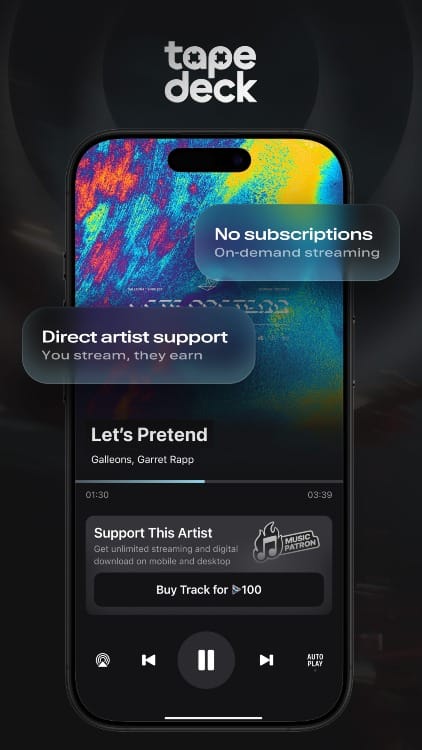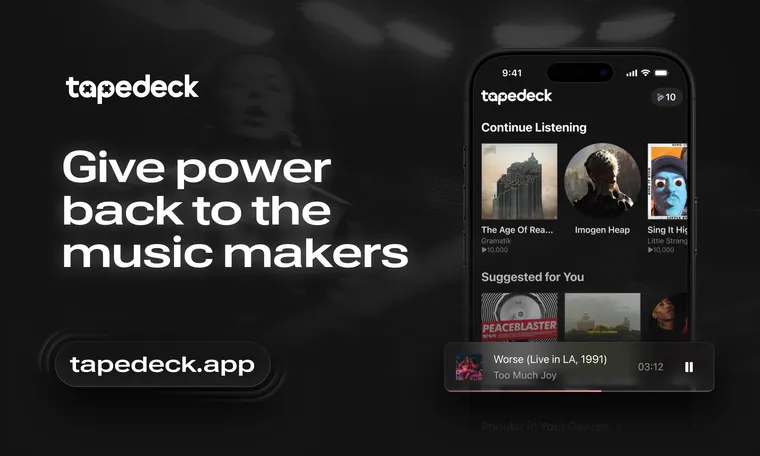by Tim Quirk
Zedge is pleased to announce the launch of Tapedeck, a new music download store and streaming service whose not-so-humble goal is to make a penny per play the floor, rather than the ceiling, for streaming royalty rates.

There’s no excuse for music streaming services to pay artists less than that. I know, because I’ve built some.
Waaaaay back in 2001, I was part of the team that launched Rhapsody, one of the first on demand music subscription services. We were paying a penny per play back then.

In 2014, I launched Freeform Development, a technology company later acquired by Zedge that built individual artist apps. We released apps featuring new albums by artists including Lil Wayne, Rob Thomas, Chris Brown, The Cult, and others. Those apps saw payouts ranging from 5 to 13 cents per play.

So how can other services get away with paying less than a third of a penny per play (or, like Spotify, simply NOT paying for the first 1,000 plays at all)?
The answer is that major labels have been setting the terms for most streaming services for nearly a quarter century now, and to my knowledge they almost never get paid based on play rates. Rather, most deals that I’m aware of contain several ways to calculate what that label is owed at the end of any month, and services must pay them whichever calculation yields the highest amount. That often means they get their pro-rated share of a certain percentage of all revenue the service earned that month (including from advertisers, as well as from subscribers who never played any music at all).
But by the time those same royalties make their way to individual artists, the vast majority of whom DO get paid by their labels per play, the individual streaming rate can come out to fractions of a penny per play – a fact I’m painfully aware of anytime I look at a Warner Bros. royalty statement for my own band, Too Much Joy.
And even when services DO pay out per-play, the total revenue can be fantastic for companies that aggregate hundreds of thousands or even millions of tracks, while the individual musicians signed to those labels still wind up struggling to pay their rent, let alone afford health insurance.
Tapedeck is designed to change all that. We want to make who’s getting paid what as easy as possible for everybody involved to understand.

- There are no subscription fees at all.
- Licensors (who might be individual artists, or labels, or distributors who handle digital rights for multiple labels) can set their own prices, for plays as well as for track or album purchases. If they want to charge MORE than a penny per play, they can.
- But those prices will always be the floor, not the ceiling, of what licensors can earn, because fans will always have the option of paying the artists they love MORE than the prices they’re asking.
- And we will always pay our licensors 80% of whatever those fans pay, for each and every track stream, and for every track or album purchase. (We use that other 20% to keep Tapedeck running.)
Tapedeck uses the same mechanics my team developed at Freeform, and which have been helping other kinds of independent artists generate millions of dollars a year in revenue since Zedge had us adapt our system for their Wallpapers and Ringtones app.
What we did at Freeform was based on my realization that there were lots of companies such as Rhapsody that were paying $15 or more to marketing affiliates for every customer those partners funneled into a free trial of the service. Since that was more than the wholesale price an artist or label would make selling a CD or digital album download, our artist apps let fans unlock unlimited streaming of the artist’s album, as well as high bitrate downloads of every track, just by signing up for a Rhapsody trial.
Everybody won: the fans got the music they loved for free, while the artists earned more than they would have selling that album to them. And if fans didn’t want or already had a Rhapsody subscription, we had an offer wall listing similar deals from dozens of other companies they could choose from. Plus they always had the ability just to purchase tracks or albums outright through the app if that was their preference.
Tapedeck will work much the same way. Every user gets 10 free credits to start, and can earn more by watching rewarded videos, by redeeming partner offers, or by buying packs of 500 or more credits at a time – we’ll also be adding additional ways for users to earn free credits, such as recommending Tapedeck to friends, etc.
Every credit is worth $0.01. The first 30 seconds of any track play are free; 1 credit gets deducted from your account any time you listen longer than that. Tracks cost 100 credits, and albums cost 1,000, but you can always pay more if you think the artists you love deserve it. Likewise, artists and labels will be able to charge more than those minimums if they wish to do so.
We recognize that Tapedeck’s model won’t be for everyone. But we’re not trying to compete with Spotify so much as we’re trying to demonstrate that there are better ways to pay musicians, and plenty of fans eager to do so. Today’s launch is the start of a three month pilot program during which Tapedeck will be available on iOS-only to people in the United States. We expect to expand to Android, and the web, as well as to other countries, throughout 2026.
We’ll also be adding lots more music during and after the pilot, so if your favorite musician isn’t in there yet, let them know about it! We’re eager to welcome them.
In the meantime, if you’re in the U.S. and have an iOS device, you can install Tapedeck and see what you think of our approach here.


